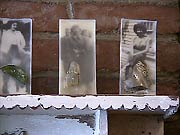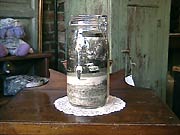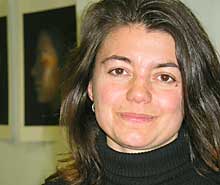


Née à Winnipeg où elle a également étudié les arts, la littérature et l'histoire à l'Université de Winnipeg, Gail Paslawski vit et travaille actuellement à Montréal où elle a terminé, en 1995, un baccalauréat en arts visuels à l'Université Concordia. Son travail, qui a fait l'objet de nombreux textes dans des catalogues et diverses publications, a été présenté à Montréal et au Québec, notamment au centre Séquence de Chicoutimi, au centre Vu de Québec ainsi qu'aux centres Dazibao et Circa, à Montréal. Récemment, dans le cadre de l'événement D'un millénaire à l'autre, on a pu voir ses œuvres lors d'expositions collectives à ARTS NDG et à la maison de la culture Ahuntsic.
Antiquaire
69, rue Villeneuve Ouest
Dans ce lieu porteur d’une mémoire universelle, une présence identitaire s’est installée. Aussi, comme on le ferait dans un lieu habité, on peut ouvrir les coffres et les tiroirs pour y chercher les traces de cette présence : divers objets et photographies chargés de souvenirs et d’odeurs. Discrets mais pourtant nombreux, ils sont étiquetés et identifiés, suggérant une enquête ou plutôt une quête d’identité perdue. L’œuvre est en fait la « réparation » de l’histoire personnelle de l’artiste, le renouement avec ses origines ukrainiennes. Restoration tente de réhabiliter la mémoire intime.
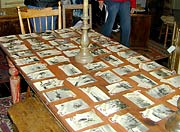
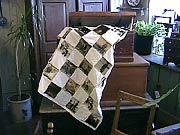
Restoration
In this place, which carries a universal memory, a specific presence has settled in. Just as one would in an inhabited place, here one can open chests and drawers to find traces of this presence: various objects and photographs charged with memories and odors. Discreet yet numerous, each object is labelled and identified suggesting an investigation, or more aptly, a quest for a lost identity. The work is in fact the "repair" of the artist’s personal history, the rediscovery of her Ukrainian roots. Restoration attempts to rehabilitate intimate memory.
STATEMENT
Within the environment of the "antiquaire", I have attempted to create a site-specific installation with historical photographs, objects, and sculptural elements, placed throughout the space's numerous tables, cabinets, closets, boxes, and drawers. Referencing the potential of the photographic image as precious object of memory, history, and culture, the site avails itself as a construction of archive and artifact.
The restoration element of the antique collector's process lends itself to the idea of collecting family photographs and ordering them in a manner which attempts to preserve or 'restore' some sense of cultural identity and family history. As each unique item is placed in the antique shop, with careful attention to presentation of its best qualities, so is the family album sorted and arranged to create or present a history. As each photograph has the ability to recount the past, each item in the space is able to take the viewer into another time and reality.
Within this work, I have explored the links between memory and identity and their relation to the photographic image. As the historical images available to me are essentially found photographs, coming from a family collection without a reference to person, place, or time, they are thereby left anonymous, open to individual interpretation. With this aspect in mind, I have examined the notion of selected or fabricated memory. Therefore, the power of the photograph to document and provide factual insight is questioned as the viewer incorporates his or her own imagination and knowledge into the understanding of what the image represents.
Working with the elements of the space and the process of the antique dealer, these fragments of memory were installed in a manner to emphasize the societal obsession to collect, classify, display, and identify in order to reference the past and contribute to an understanding of a present form of reality or identity.
In reflection of my art practice, this installation encourages a continuation of themes relating to the physical embodiment of evidence or artifact‚ and the metaphoric translation of time‚ associated with concepts of evolution, transformation, and transition.
